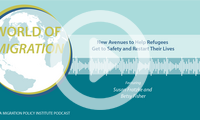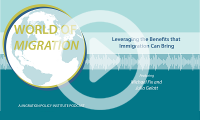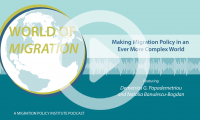Selection Systems
Recent Activity
Marking the launch of MPI’s Global Skills and Talent Initiative, this webcast features senior policymakers and other experts discussing the extent to which labor market needs should shape future immigration policy decisions, and how countries are adjusting—and could adjust—their immigration systems to meet human capital and competitiveness needs.

How could humanitarian migrants with skills and experience use existing work or study visa pathways to fill labor market needs in destination countries? MPI’s Susan Fratzke speaks with Betsy Fisher, U.S. Director of the nonprofit Talent Beyond Boundaries, about complementary pathways as an innovative addition to refugee resettlement and asylum.

In this World of Migration podcast episode, MPI Senior Fellow Michael Fix speaks with Senior Policy Analyst Julia Gelatt about the fiscal impacts of immigration, the importance of immigrant integration, how a greater focus on credential recognition could allow immigrants to more fully utilize the academic and professional skills they bring with them, and much more.

MPI co-founder Demetrios G. Papademetriou takes on many questions, including whether the role of think tanks has evolved over the last two decades, in this World of Migration conversation with MPI’s Natalia Banulescu-Bogdan. They also look ahead to the challenges that will dominate immigration policymaking in the years ahead.

What actions might the incoming Biden administration take on immigration, whether to unwind some of the most restrictive Trump policies or advance an affirmative agenda of its own? And what challenges and opportunities will the Biden administration face?




















Canada's New Tech Talent Strategy Takes Aim at High-Skilled Immigrants in the United States
Regional Processing Centers: Can This Key Component of the Post-Title 42 U.S. Strategy Work?
Beyond the Border: Opportunities for Managing Regional Migration between Central and North America
Labor Shortages during the Pandemic and Beyond: What Role Can Immigration Policy Play?
Brexit Day—Is This the Dawning of the Age of Immobility?
Through the Back Door: Remaking the Immigration System via the Expected “Public-Charge” Rule
The Diversity Visa Program Holds Lessons for Future Legal Immigration Reform
The RAISE Act: Dramatic Change to Family Immigration, Less So for the Employment-Based System
The Revised Trump Travel Ban: Who Might Be Affected from the Six Targeted Countries?
Leaked Draft of Possible Trump Executive Order on Public Benefits Would Spell Chilling Effects for Legal Immigrants
Pages